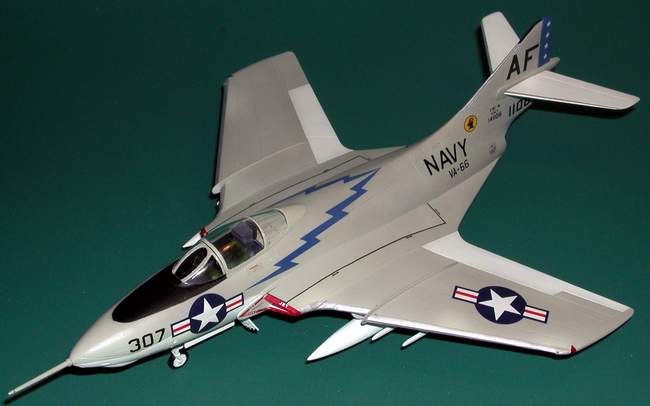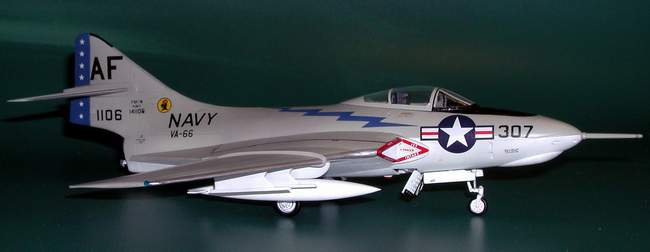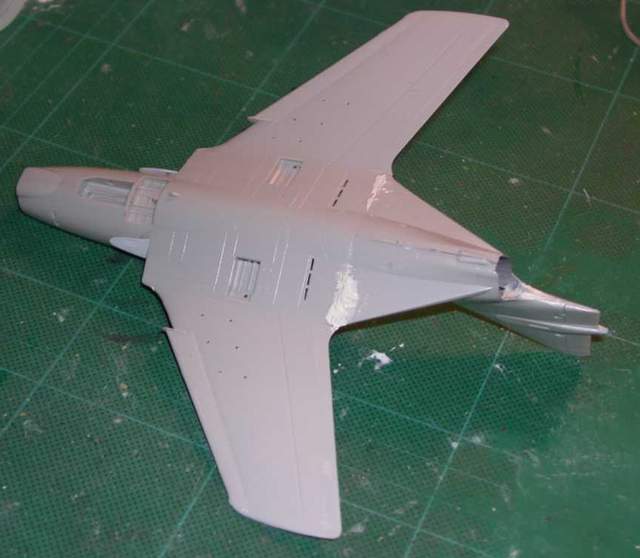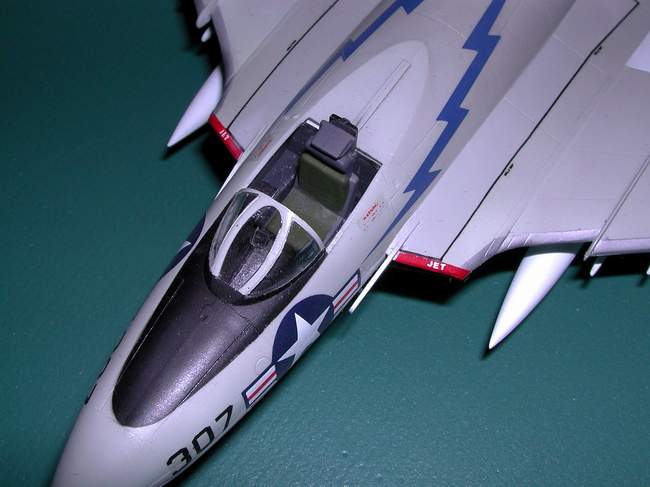|
Hasegawa's 1/72 scale
Grumman F9F-8 Cougar
by Dan Lee
|
 |
|
Grumman F9F-8
Cougar |

HyperScale is proudly supported by Squadron
The Cougar for all intents was
Grumman’s low risk, swept wing version of the Panther. A
contract for 3 prototypes was received on Mar-1951. The
prototypes were designated XF9F-6 and first flown on
20-Sept-51. These were conversions of existing F9F-5
Panther airframes. But it was realized the differences
was sufficient to merit its new name, Cougar.
Altogether 646 P&W powered F9F-6
Cougars were built, along with 60 F9F-6P recon birds.
Also 168, Allison powered F9F-7s were built. Besides the
engine change, the –7s were identical to the original
–6s. The Allison J33 engine offered 1000 lbs less thrust
and was only built probably for political reasons.
By late 1952, the F9F-8 entered
production. This version received significant changes
over the previous –6. The trailing edge fillet was
extended to the end of the fuselage. The wing was
changed with wing chord increased outside of the wing
fences. The leading edge had a camber for improved low
speed handling. Leading edge slats on previous versions
were deleted. The larger wing housed more fuel. An
intake splitter plate and refueling probe were
eventually added.

The first flight was on 18-Dec-1953
(a F9F-6 with a –8 wing). The first production F9F-8 was
on 18-Jan-1954. The F9F-8 exceeded Mach 1 in a shallow
dive in Jan 1954. The Cougar being one of very few
centrifugal powered aircraft to do so. Total production
was only 662. As with the Panther series, a recon
version, F9F-8P was produced. A total of 110 –8Ps being
built.
The final Cougar variant was the
two-seat trainer, F9F-8T. First flight was 4-Apr-1956
and 400 were built. The last being delivered in 1959.
The –8T was not officially retired until Feb 1974 by
VT-4
Internal armament was four 20mm
cannons. External stores included two drop tanks and
four AIM-9 Sidewinders or four 500lbs bombs.
The Blue Angels flew with the F9F-8
and one –8T from 1955 to 1958.
Cougars were just getting into
Korea when the war ended. The single seaters never saw
any combat sorties. Only the F8F-8T flew in the Vietnam
war as FACs by the US Marines.
Hasegawa’s 1/72 F9F-8 Cougar
|
This is Hasegawa’s Cougar kit and
was purchased as a bagged kit for $5CDN (no
instructions, nor decals). I must say the Cougar isn’t
an inspiring topic and not surprisingly, Hasegawa’s 72nd
offering is the only game in town. But in the bigger
scales the Cougar is represented by Collectaire,
Fonderie Miniatures in 1/48 and Fisher Models in 1/32.
With Hobbycraft/Trumpeter 1/48 Panther release, a Cougar
may follow.
The kit contains two light grey
spruces. The clear spruce consists of a two-piece
canopy, gun sight and ventral beacon light.
Panel lines are recessed. Cockpit
detail is basic. The seat and side console space is
suspiciously oversized. Landing gear and airbrake bays
are also basic. Airbrakes can be built in the opened
position. An optional nose cone (no cannon and refueling
probe) is included; to be used for the Blue Angels
scheme. External stores include two 150 gallon tanks and
four AIM-9 Sidewinders. Intake ducting and a full
exhaust can is provided to prevent a see-through effect.
An optional extended boarding step is also provided.
As a typical model, construction
began with the cockpit. The side consoles are at least
twice as wide as F-15Cs. So I decided to build up
sidewalls to reduce the width. The cockpit was painted
with a mix of Tamiya neutral grey and black for a dark
gray/black. Generic instrument decals were used for the
panel details. No attempt was made to make it accurate;
only busy.

It was only later when the cockpit
was sealed in the fuselage that I found out that the
cockpit color should have been gray for the gull grey /
white color scheme. The glossy sea blue color scheme had
cockpits that were black.

The rear intake assemblies were
added at this point. Plastic strips were added to
provide support for the rear wing to fuselage joint.

The wing assembly consisted of a
one piece lower section and two upper wing halves. The
holes for the wing pylons need to be opened up before
gluing down the upper wing halves. The entire wing
assembly can then be joined to the fuselage. Some putty
was required at the rear fuselage to wing joint. This
was mainly due to fact that my lower wing was slightly
warped.

The forward intake portion is
conveniently molded separately. It was at this time that
the intake interiors were painted flat white along with
the red strip at the inside intake lip.
Abit of lead weight is required in
the nose cap which is sufficient to prevent a tail
sitter.
Once the forward intakes, nose cap
are glued and putty work cleaned up, it was time for
painting.
Landing gear n doors, pylons, fuel
tanks and missiles were assembled and painted
separately.
As a bagged kit, no decals were
included. I did managed to find Micoscale’s 72-329 at
D&J Hobby in Campbell, CA. This was probably the only
set out there. It includes decals for a Gull Grey/White
Cougar 141106 from VA-66, 1958, USS Intrepid. Nose
number is 307 with tail code AF.
Paint
Being a simple Gull Grey/White
bird, Gunze Sangyo H315 Gray FS16440 was used for the
upper surfaces. Tamiya flat white was used for all lower
surfaces details and for the entire horizontal
stabilizers. Testors metallizer flat aluminum was used
for all leading edges. All these colors were airbrushed.
Masking tape was used to produce a
hard edge between the gull grey and white. The anti
glare panel was masked and flat black was air
brushed. The outside red intake lip strip was masked and
also air brushed.
The black and metal leading edge on
the vertical fin was hand painted by brush.

Pictures of some –8Ps had the
walkways as a black color. Earlier –8s had variations of
grey with black outline or no indications of a defined
walkway. I decided to add some excitement and painted
the walkways with Gunze H325, Gray FS26440 and later add
the black outline with decal strips.
Future was airbrushed prior to
decaling.
Decals
In terms of aftermarket Cougar
decals, there isn’t much. There appears to be only
MicroScale’s 72-207 and 72-329. Others may exist but I
haven’t searched.
The decals are from a different
era; pre computers. They can’t compare to the current
Superscale stuff. Couple of the smaller letters tended
to fade, blur or be malformed. The larger numbers and
letters were acceptable.
Being Microscale decals, they
reacted well to Micro Sol setting solution. This was
essential to get the rudder’s blue with white stars
decals to wrap around the edges. The end result looks
painted.
One blunder with the decal sheet,
is that there are two left sided ‘Danger Jet Intake’
decals for the splitter plates. The right side was built
using spare decals and cutting up one of the existing
lefts.
The wing walkway strip and
lettering was made from spare decals.
Click the thumbnails
below to view larger images:
Gunze Flat coat was used to seal
the decals and degloss the future. No attempt was made
at weathering.
Finally Tamiya clear red and blue
were used for the various lights.
Hasegawa’s F9F-8 Cougar was a
simple and easy kit to put together. The gull grey/white
paint scheme and Micoscale decals were also very easy to
work with.
For those building 1950’s US Navy
72nd scale collection, this kit is the only
game in town and recommended.
References:
Detail & Scale F9F Cougar, Vol 16,
1983, Bert Kinzey.
Great Carrier Aircraft, 1996, Peter
Darman.
Click the thumbnails
below to view larger images:
Model, Images and Text Copyright © 2007
by
Dan Lee
Page Created 26 March, 2007
Last Updated 04 June, 2007
Back to HyperScale
Main Page
|
Home
| What's New |
Features |
Gallery |
Reviews |
Reference |
Forum |
Search